Archive for the ‘photography’ Tag
Return to Medicine Bow
Two summers ago I posted about the mix of beauty and devastation in Wyoming’s Medicine Bow National Forest. It was a similar story upon returning this August: this year’s heavy rains and enduring snow packs meant another incredible burst of wildflowers. (As well as some tragic flooding.)
Sadly, the fallout from climate change also continues here. Because winter temperatures are no longer as cold, the bark beetle population continues to survive and thrive, killing off the pine forests. This was a typical sight in the vicinity of the Sugarloaf recreation area:
Bonus shot: Train tracks in Laramie.

See photos from the trip in 2009 and read more about climate change and the region’s bark beetle epidemic here.
Lake Mead’s dwindling waters
The future is looking parched for the roughly 30 million Americans who rely on the Colorado River, according to a report in the Wall Street Journal. Denizens of Las Vegas, Phoenix and Los Angeles, this especially means you:
Water managers warn that Lake Mead, the West’s largest and most important reservoir, remains perilously near the level of 1,075 feet at which the U.S. Secretary of the Interior would likely declare a water shortage, for the first time in the nearly century-old history of the Colorado River system. Such a shortage would parch Nevada, Arizona and California with severe water-use restrictions. There alone, some 20 million people depend on Lake Mead’s supplies.
Despite this year’s rain-soaked winter and a modest rise in the lake, the region still faces a deep deficit from a 12-year drought: “Lake Mead’s water level now stands at 1,096 feet, near its lowest point since the reservoir began filling in the 1930s and 110 feet below when the drought began in 1999, according to the U.S. Bureau of Reclamation. The lake last rose in 2005.”
Statistics can be elusive. One of the best ways to realize the change is from directly on the lake itself. Last August I took a houseboat trip with some friends on Lake Mead, where I snapped some photos showing the drop in the water line. The lake is enormous — but so is the space no longer filled with water:
In the west we’ve peered into the future, which is now. It is conservation.
(According to the water footprint “calculator” linked above, which uses criteria ranging from shower times to car washing to meat consumption, my household of two rates at approximately 12 percent below the daily average for water consumption across American households. Not bad, though as I suspected there’s still room for improvement. The site suggests specific areas for potential progress based on your questionnaire answers.)
Postcard from Vancouver
A few snapshots from the final weekend here at the 2010 Winter Games.
The Olympic Cauldron at the convention center in downtown Vancouver, early Saturday evening:
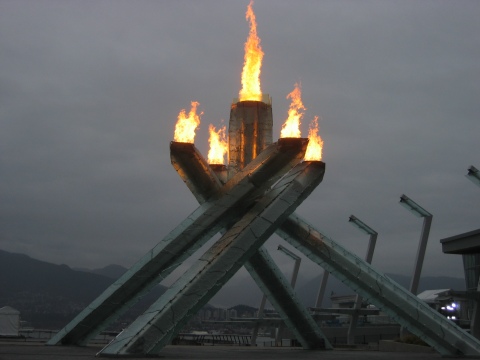
The Olympic Rings on a barge just off Stanley Park in Coal Harbour, early Saturday evening. Every time Canada won a medal, the Rings changed color for a little while accordingly, to gold, silver or bronze.
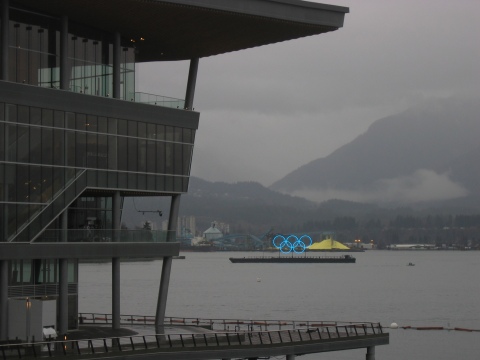
 By mid morning on Sunday, every single drinking establishment in the downtown area had a line around the block in anticipation of Canada facing off against the United States in the hockey gold medal finale. Some people were offering $100 just for a guaranteed spot to watch the game… in a bar. On Saturday night, some tickets to the game for sale online apparently were going for as much as $10,000.
By mid morning on Sunday, every single drinking establishment in the downtown area had a line around the block in anticipation of Canada facing off against the United States in the hockey gold medal finale. Some people were offering $100 just for a guaranteed spot to watch the game… in a bar. On Saturday night, some tickets to the game for sale online apparently were going for as much as $10,000.
A building at Georgia and Burrard streets draped in the Canadian flag:
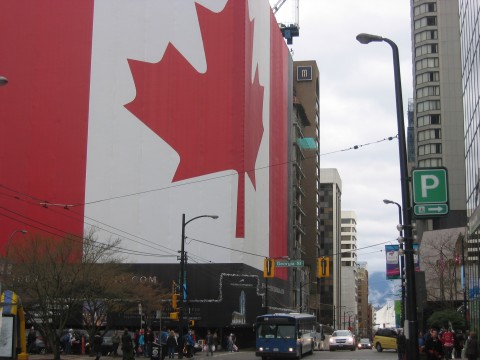
Vancouver is an international city on a normal day, but for the past couple of weeks has transformed into a truly global village, with legions here from all over the world. It’s been fun just to walk the streets and mingle with the excited and friendly (and youthful) masses:
Bonus question: Is it really true that Russian skater Victor Plushenko was once an American rock star?
Big bake sale for Cary Tennis and King Kaufman
 Around the turn of the year, two friends and former colleagues of mine at Salon, Cary Tennis and King Kaufman, were hit with serious health emergencies. In November, Cary announced in his beloved advice column that he was diagnosed with a rare cancer, sacral chordoma, and would have to undergo surgery, which took place on December 17th. Vividly and eloquently, he has been keeping friends and fans apprised of his situation on his Open Salon blog.
Around the turn of the year, two friends and former colleagues of mine at Salon, Cary Tennis and King Kaufman, were hit with serious health emergencies. In November, Cary announced in his beloved advice column that he was diagnosed with a rare cancer, sacral chordoma, and would have to undergo surgery, which took place on December 17th. Vividly and eloquently, he has been keeping friends and fans apprised of his situation on his Open Salon blog.
 In early January, King was suddenly taken ill and hospitalized for a rare, devastating ailment, Guillain-Barré syndrome, the cause of which is essentially unknown. Fortunately, after three weeks in the hospital and a physical rehabilitation center, he is now back home with his wife and young kids, on his way to what his doctors say is likely to be a full recovery.
In early January, King was suddenly taken ill and hospitalized for a rare, devastating ailment, Guillain-Barré syndrome, the cause of which is essentially unknown. Fortunately, after three weeks in the hospital and a physical rehabilitation center, he is now back home with his wife and young kids, on his way to what his doctors say is likely to be a full recovery.
 For most people nowadays, a serious health crisis inevitably brings with it some financial strain. Friends of Cary and King have rallied to put together a terrific auction on eBay, the proceeds of which will go toward supporting these two great guys through their difficult times. A throng of talented and accomplished Salon alumni have contributed: Dave Eggers, Zach Trenholm, Heather Havrilesky, Keith Knight, David Talbot, Scott Rosenberg, Kate Moses, Larry Smith and Laura Miller, to name a few. The array of items up for bid include signed first editions of books, photographs, paintings and other original artwork. More details about the project on this Web site set up by the talented and generous Mignon Khargie.
For most people nowadays, a serious health crisis inevitably brings with it some financial strain. Friends of Cary and King have rallied to put together a terrific auction on eBay, the proceeds of which will go toward supporting these two great guys through their difficult times. A throng of talented and accomplished Salon alumni have contributed: Dave Eggers, Zach Trenholm, Heather Havrilesky, Keith Knight, David Talbot, Scott Rosenberg, Kate Moses, Larry Smith and Laura Miller, to name a few. The array of items up for bid include signed first editions of books, photographs, paintings and other original artwork. More details about the project on this Web site set up by the talented and generous Mignon Khargie.
The auction begins on Tuesday, February 9, and runs through the rest of the week; please check it out here and bid on any of this great stuff in support of Cary and King.
The spirit of Haida Gwaii
In late August I returned to the archipelago of Haida Gwaii, a place whose ancient, complex culture and astonishing natural beauty are inextricable. Earlier this week, in the village of Old Massett, the renowned Haida artist Robert Davidson hosted an epic two-day celebration commemorating the totem pole he carved here 40 years ago. The pole was raised in the village on August 22, 1969, replanting a vital Haida tradition that had nearly disappeared by the end of the 19th century. It was a privilege and joy to attend the festivities and to participate in documenting them. Here are a few images I captured (please do not reproduce them without permission), though they only begin to suggest the layers of landscape, art and ceremony that were on display.
The many performers included singers, drummers and dancers from Skidegate:

Spruce-root woven and painted hats filled the community hall:

The Tsimshian group Git-hoan, or People of the Salmon, were among the guests invited to perform:

Eagle Transformation Mask, carved by Robert Davidson and danced publicly for the first time by the Rainbow Creek Dancers:
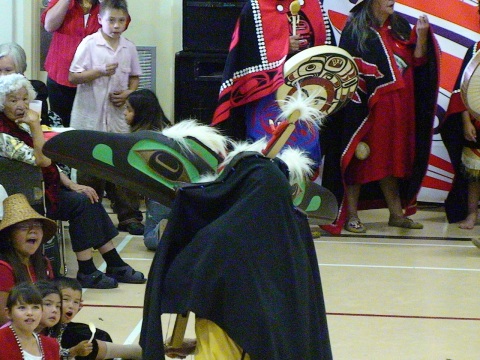

Robert Davidson’s 40-foot Bear Mother pole (partial view), raised in Old Massett in August 1969:
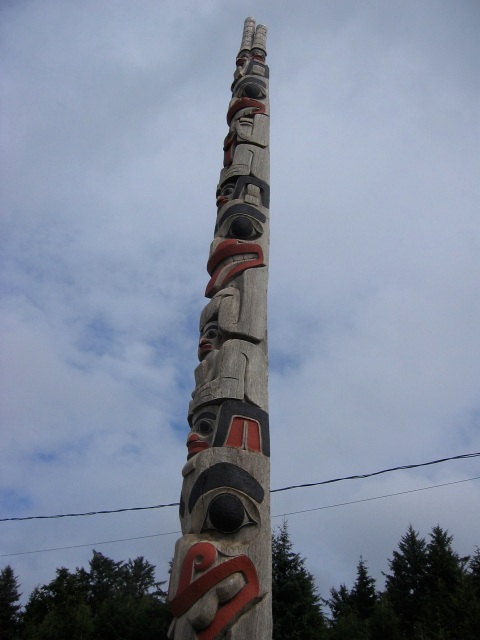
Despite devastation from decades of industrial logging, some majestic old trees still stand on Haida Gwaii. (Thanks to the tireless efforts of local advocates and defenders, the land increasingly has come under protection in recent years.) The temperate rain forests are home to towering cedar, hemlock and spruce:
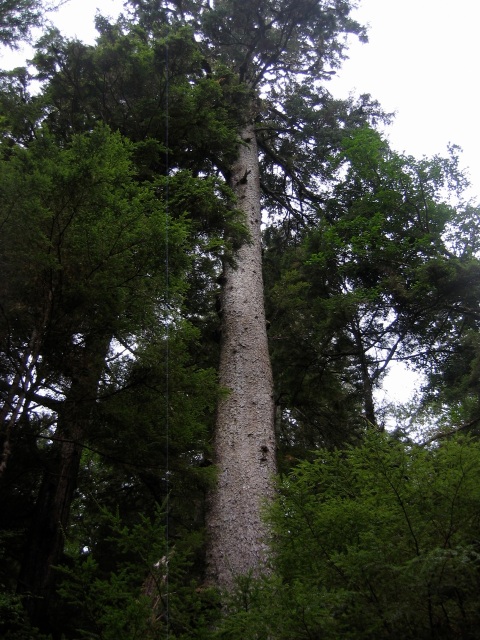
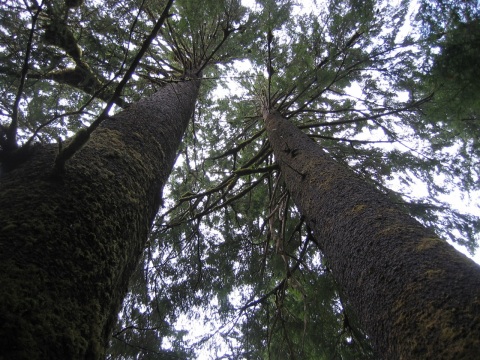
Along the banks of the Yakoun River, near where K’iid K’iyaas, the legendary Golden Spruce stood until its untimely demise in 1997. Every year the salmon come back to this essential river artery of Haida Gwaii. At least for now.

A Supposedly Fun Thing That Seems to Kill Whales
I took notice back when David Foster Wallace chronicled the cultural dark side of going on a cruise. But ultimately it’s the environmental dark side of the industry that makes me know I’ll Never Do It at All.
Over the weekend, an adult fin whale — a threatened species in Canada — turned up dead in the waters at a cruise ship terminal in Vancouver. The rare marine giant was impaled on the bow of the “Sapphire Princess,” a Princess Cruises’ ship arriving from Alaska:
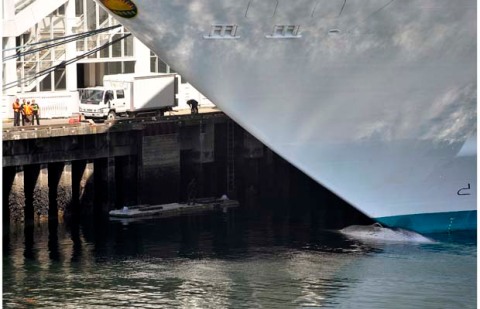
(Jenelle Schneider/Vancouver Sun)
Tragic, gruesome and strange — the size of the ship really begins to sink in when you realize that the dead fin whale pictured above is approximately 70 feet long, a magnificent giant cruelly rendered small. (More photos here in the Vancouver Sun’s report, and more here on Flickr.) Consider, also, that soon the 2,670-passenger Sapphire Princess won’t even nearly measure up to the largest, most consumptive recreational beast riding the seas. That’ll be the stupefying Oasis of the Seas.
According to the Vancouver Sun, the Department of Fisheries and Oceans will conduct a necropsy to determine if the ship struck the fin whale while it was alive or if the whale had already been floating dead at sea and got caught on the bow. The latter seems the less likely scenario. A fisheries spokesperson, Lisa Spaven, appeared to acknowledge as much: “Vessel strikes are a very real threat to fin whales,” she told the Sun.
Moreover, an account I heard today from a source in Vancouver appears to contradict a statement put out by Princess Cruises this weekend regarding whales in the vicinity of the ship.
“It is unknown how or when this could have happened, as we have strict whale avoidance procedures in place when our ships are in the vicinity of marine life,” the statement from the cruise company said. “We are not aware that any whales were sighted as the ship sailed through the Inside Passage to Vancouver yesterday.”
But according to my source, two passengers who arrived on the Sapphire Princess in Vancouver this weekend said that several passengers on the ship had seen whales swimming around and under the ship as it traveled the Inside Passage cruise route just north of Vancouver Island.
Spaven, the DFO spokesperson, told the Vancouver Sun that she believes the whale was struck north of Vancouver Island, since fin whales aren’t normally found in the straits closer to Vancouver.
The Inside Passage is famously rich with marine wildlife and is a crucial habitat and migratory route for whales. As the Sun also reports: “This is the second time in the last 10 years that a cruise vessel has come into the Port of Vancouver with a whale caught on the bow. In that instance, in June of 1999, the Celebrity Cruise vessel MV Galaxy collided with an adult male fin whale, which likely happened as the ship transited the Hecate Strait north of Vancouver Island.”
For some compelling related reading, I strongly recommend Charles Siebert’s article “Watching Whales Watching Us,” published recently in the New York Times Magazine. It’s a deep, enthralling account that dives into some provocative thinking among marine biologists today about our evolving relationship with whales — which may yet hold hope, despite our terrible history of assault on one of the earth’s most sublime creatures.
PART 2:
There is more to Princess Cruises’ history with whales. In the summer of 2001, one of its ships slammed into a pregnant female humpback whale in the waters off Southeast Alaska, killing it. As Mother Jones reported two years ago via a National Park Service report, in January 2007 “Princess Cruise Lines pled guilty in U.S. District Court in Anchorage to a charge of knowingly failing to operate its vessel, the Dawn Princess, at a slow, safe speed in the summer of 2001 while near two humpback whales in the area of Glacier Bay National Park. The bloated carcass of a pregnant whale was found four days after the Princess ship sailed through the park. It had died of massive blunt trauma injuries to the right side of the head, including a fractured skull, eye socket and cervical vertebrae, all consistent with a vessel collision.”
You can read the rest of the report at the MoJo link above, including details of the six-figure penalty paid by Princess in a plea agreement. At the time of the agreement, the U.S. attorney’s office stated, “in this case we feel Princess has stepped up and made significant, voluntary operational changes that protect whales and the marine environment.”
Pending findings on the Sapphire Princess and the fin whale’s death, perhaps that assessment needs updating.
I’m compelled to add that I feel a particularly personal sense of investment in this story. Exactly a decade ago, I was fortunate to have an opportunity to travel into Glacier Bay, along with three good friends, on a 10-day sea kayaking trip. I’ve explored deep wilderness throughout my life, and Glacier Bay was among the most memorable places I’ve ever been. On a couple of days during the trip, we spotted cruise ships on the horizon. We were thankful to be far away from them. In this photo I took from my sea kayak in July 1999, you can see a large cruise ship in the distance (at the right-center edge of the image) heading north against the backdrop of the Fairweather Range.
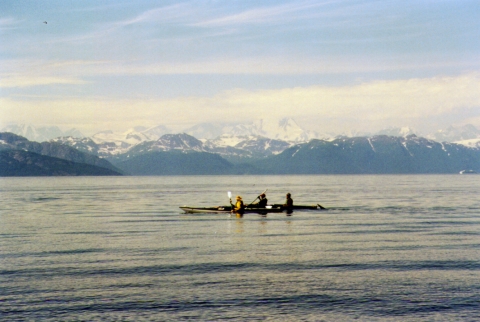
We camped on nearby shoreline that night, where an exquisite sunset perhaps hinted at what was to come on day nine of our trip.
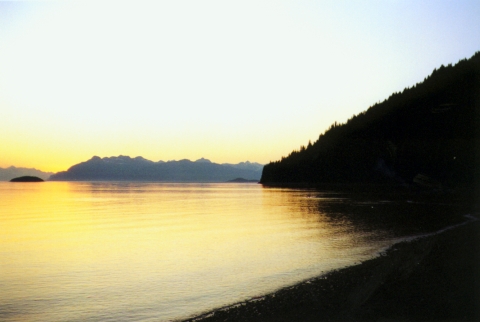
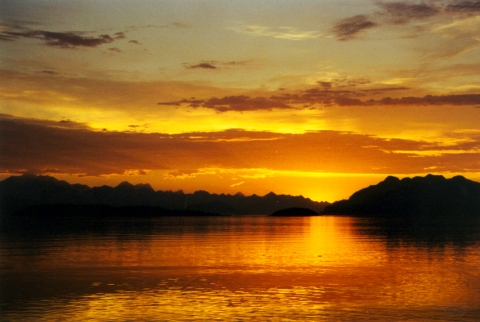
The next morning we paddled into the placid waters of Beartrack Cove to the east. We were sole representatives of humanity in a place that sees little of it. There were colorful marine birds, salmon returning to spawn in coastal streams… and suddenly that morning, one enormous humpback whale. It surfaced about 30 yards in front of our tiny, tiny boats.
The whale appeared to be feeding, its dark mass breaking the surface several times with its huge mouth open. We stopped paddling and tapped the rails of our boats gently to let it know our location. We watched in awe as it reappeared around us at various spots in the cove for about half an hour before it submerged for other waters.
It was the most glorious kind of nervous I think I’ve ever felt, a truly unforgettable experience.
Medicine Bow: A tale of beauty and devastation
Late last week, as world leaders were again failing to make progress on the rising threat of climate change, I was hiking to the top of Medicine Bow Peak in Wyoming. An unusually wet June produced a stunning sweep of wildflowers high upon the 12,000-foot mountain:

Combating global climate change is a complicated matter, to say the least, but I suspect that most people, attendees of G-8 summits included, would view the imperative in a whole new light if they were to witness the ecological devastation hitting this breathtaking region of the Mountain West. The fallout can be seen in the lush forests ringing Medicine Bow and other majestic snow-capped ranges in the area and in nearby Colorado — in the bleak, sprawling signature of an ongoing bark beetle epidemic. Warmer winters and drought in recent years allowed the insect population to explode, bringing destruction to more than 1.5 million acres.
“By about 2012, beetles will have killed nearly all of the mature lodgepole trees in northern Colorado and southern Wyoming,” reports the USDA Forest Service, “affecting water flows and watersheds, future timber production, wildlife habitat, recreation sites, transmission lines and scenic views. Beetle-killed trees also present a fuels build-up situation that could result in catastrophic wildland fires. These events pose threats to homes and property and could cause adverse economic impacts to communities.”
According to Erik Molvar, a wildlife biologist in Laramie, the beetle infestations have been roaring on unabated because of climate change. “These infestations take place naturally on 20- to 40-year cycles,” he said in a news article early last year. “In the past, they’ve run their course until a bitterly cold winter took place. Studies show that you need a two-week cold snap at minus 20 degrees Fahrenheit to kill off the beetles. Nothing else works.”
For several years now, it hasn’t gotten cold enough.
The forests seen here in the distance from the top of Medicine Bow…

… could soon resemble these seen in this recent aerial photo, taken in northern Colorado, from the USDA Forest Service:

Some other forested areas I saw last week in the vicinity of Medicine Bow (especially at lower elevations that stay warmer) are already riddled with dead and dying trees. The friends I was with, who’ve been coming to the area for the last decade, described the accumulating damage in dramatic terms — some pristine expanses that existed just a couple of years ago won’t be seen again in our lifetime.
It’s hard to know how bad it might get (it’s already bad), or whether anything can actually be done to slow or stop this particular disaster. But it’s one stark example of what climate change can bring, and why we have to pay attention. Over the weekend Timothy Egan argued that Michelle Obama should throw her political weight behind America’s increasingly marginalized national parks. Egan’s perspective was more cultural than environmental, but from what I saw in Wyoming, there’s no lack of pressing reason on the latter front, either.
Or perhaps, as Emerson suggested in his famous essay on nature, what’s ultimately at stake is an essential interdependence:
“The tempered light of the woods is like a perpetual morning, and is stimulating and heroic. The anciently reported spells of these places creep on us. The stems of pines, hemlocks and oaks almost gleam like iron on the excited eye. The incommunicable trees begin to persuade us to live with them, and quit our life of solemn trifles.”
Postcard from Wyoming
Did Joe Biden just give Israel the green light to attack Iran? Is Sarah Palin completely cuckoo? Have we reached the saturation point on Michael Jackson yet?
Apologies, dear readers, but I don’t have a lot to say about current affairs at the moment. (Anyway, Palin’s baffling resignation speech more than speaks for itself.) What I do have are a few photos I took during recent travels with friends in the great state of Wyoming. Enjoy…
*
July 4th festivities in the town of Saratoga:



At the bar inside the Hotel Wolf:

Twilight commemoration involving ignition:



Thunderstorm approaching over Laramie:

At the base of Medicine Bow peak:
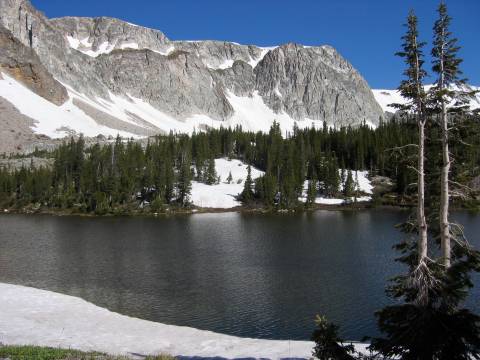
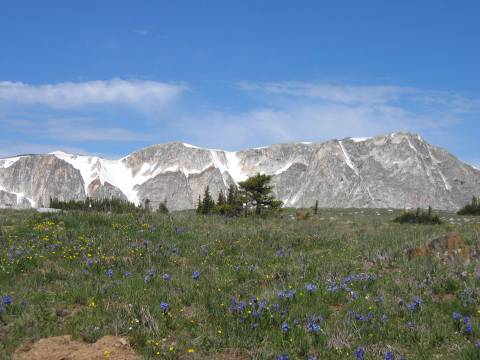
The long goodnight
For a number of reasons Vancouver at this time of year is a great place to be doing some research and writing. Among them is that the sun doesn’t wink out entirely until about 10pm. This was Monday evening, overlooking English Bay.

 Leave a comment
Leave a comment








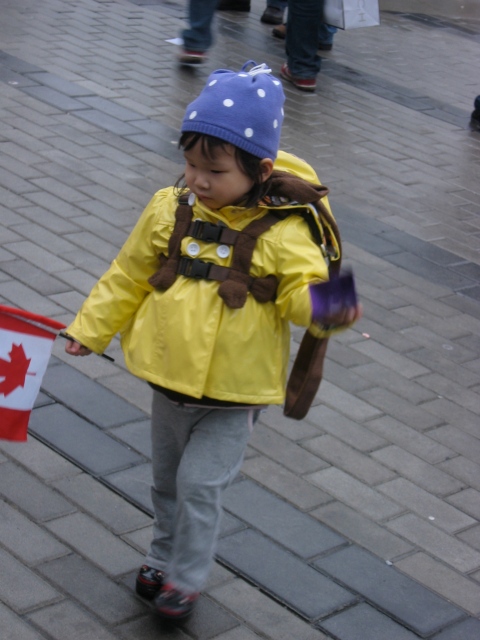


You must be logged in to post a comment.